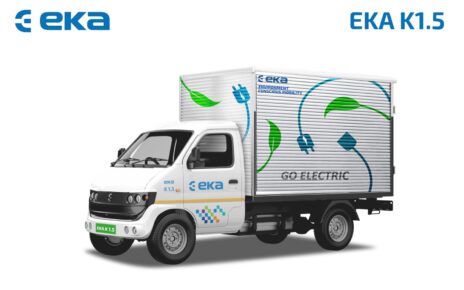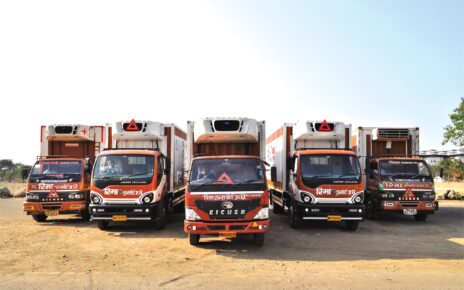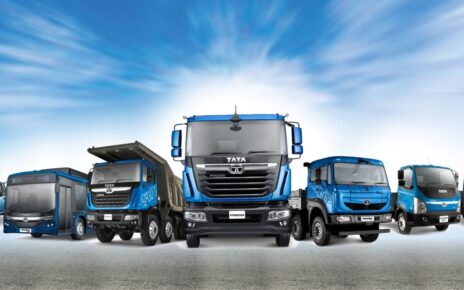As the Indian economy continues to expand its infrastructure footprint and digital commerce accelerates across Tier 2 and Tier 3 markets, the commercial vehicle (CV) industry is seeing a reshaping of its own. In an exclusive interview with MOTORINDIA, Sanjeev Kumar, President – M&HCV at Ashok Leyland, shares strategic insights into the company’s growth blueprint, technology roadmap, and customer-first approach.

India’s Growth Engine Still Roaring
Reflecting on the current state of the CV industry, Sanjeev Kumar offers a reassuring perspective: “This industry continues to see volumes for the fourth year running, which to me showcases underlying strength. I’ve seen the industry go through its share of cyclical downturns, but this level of consistency signals a healthy and maturing market.”
The optimism is grounded in first-hand observations. Sanjeev, who travels extensively, sees encouraging signs: infrastructure projects regaining pace, a growing e-commerce footprint reaching deeper into rural India, and a resurgence in states like Bihar and Odisha.
“The industry is also witnessing a significant growth in some states where government has increased its focus on building highways, airports and industrial corridors. State policies are transforming previously dormant territories into emerging growth centres across Central, Northern and Eastern parts of India.”
The Growing Divide: Fleet vs Retail
While large fleet operators are scaling up rapidly, the retail buyer is under stress. Sanjeev outlines three critical shifts post-COVID: cautious bank financing, a GST framework that favours larger fleets, and differentiated OEM engagement.

Retail operators are opting for the reverse charge mechanism, but that cuts them off from GST benefits. That’s hurting them” he states. “Unlike large fleet customers who can leverage scale, retail buyers struggle with both acquisition costs and operating economics.”
He points to a structural imbalance: “When someone is buying a hundred trucks, the OEM, dealer, and financier all line up to support. A single truck buyer doesn’t get the same attention – be it price, , or financing terms. This asymmetry accelerates consolidation.”
Sanjeev acknowledges that while consolidation is a market phenomenon, preserving the health of the retail segment is essential. It’s not just about regulation. It’s a shared responsibility across stakeholders to ensure that smaller operators don’t get left behind.
EVs: Early Days, but the Wheels Are Turning
On the electric mobility front, Sanjeev remains pragmatic. “There’s a lot of talk, but on-ground uptake in M&HCVs is still limited” he admits. “Fleet operators are interested, but when you tell them the price of an EV truck is significantly higher than its diesel counterpart, it becomes a tough sell.”
Despite cost and infrastructure barriers, Ashok Leyland has made tangible progress. “We’ve already done over 300,000 km of operations on our electric trucks across applications like ports, cement, steel, and mining. These are predominantly on closed-loop operations, ideal for current EV range capabilities.”

“In ports, for example, the routes, charging cycles, and turnaround times are well established and hence it is easier to plan. In e-commerce, we have delivered the first lot of electric trucks and are working with the transporters to further refine their operations. As battery tech improves and states introduce more incentives like Maharashtra and UP have done, adoption will accelerate.”
He emphasises that EV adoption isn’t transactional. “We work with our customers to co-create these solutions. It’s a learning journey for both sides. We monitor performance, provide operational training, and even assist in route planning.”
LNG, Hydrogen, and the Transition Fuels
Ashok Leyland is also betting on LNG as a bridge fuel, albeit cautiously. “It’s not just about the vehicle. You need reliable refuelling infrastructure, predictable pricing, and strong ecosystem partnerships. Without that, operators hesitate.”
The company is in active dialogue with gas distribution companies to build this ecosystem. “We’re trying to answer the long-term question operators have: will LNG be viable three years down the line?”
Sanjeev also shares early learnings on hydrogen: “We’ve deployed hydrogen-powered fuel-cell trucks in mining operations. Fuel cells may be the future, but right now hydrogen ICE seems more likely to meet operating economics. Again, it all comes down to TCO – if it doesn’t make economic sense, it won’t scale.”
AC Cabins: Comfort Driving Compliance
Regulatory changes mandating AC cabins have been a non-issue for Ashok Leyland. “We were already producing BS6-compliant vehicles with AC cabins. The regulation only accelerated the migration” Sanjeev notes.
“Earlier, customers saw AC as a luxury that impacted fuel economy. Today, they understand driver comfort improves productivity. The perception has flipped.”
To ensure performance even in externally built cabins, the company is training third-party body builders. “We want AC cabins to be truly effective, irrespective of where they’re built. That’s why we are investing in training and awareness.”
Network Expansion and Market Share Vision
With clear aspirations of market share growth, Ashok Leyland is focused on regional penetration. “TIV is unevenly distributed. North contributes almost 34%, South about 21%. We’re focusing on geographies like Bihar, Jharkhand, and Odisha that are seeing a spike in industrial activity.”
“Two years ago, we were at 25% share in some of these regions. Now we’re aiming for 30%, backed by our network expansion. We’ve gone from 625 to over 1,100 service touchpoints across the country.”
“Earlier, servicing a truck in Ladakh could take a fortnight. Today, we can respond within a day. That’s the level of transformation we’ve achieved.”
Ashok Leyland is also driving digital transformation in after-sales. “Our Uptime Solution Centre in Chennai is proactively monitoring BS6 vehicles. Last month alone, we made 5,000+ preventive maintenance calls, sharing driver behaviour reports and fuel efficiency data.”
From Product to Partnership
“Today’s customer doesn’t just want a truck. He wants a comprehensive solution. He wants to know how to get maximum efficiency from each truck and driver,” Sanjeev explains.
That shift has led to a change in OEM mindset. “Our focus is now on training drivers, monitoring operations, and helping customers improve TCO. We’re not just suppliers; we’re co-pilots in their business journey.”
Fleet customers are even seeking partnerships on EV tenders and LNG solutions. “They want us to engage as long-term collaborators – tripartite models involving OEMs, fuel providers, and end-customers are emerging. It’s a different business model altogether.”
Financial Partnerships and Ecosystem Strength
On financing, Sanjeev acknowledges the critical role of banks and NBFCs. “They bear the risk. So we need to instil confidence in our brand, our technology, and our TCO metrics.”
Ashok Leyland has organised tech days for financial partners, insurers, and leasing companies. “We help them understand EVs, residual value implications, and battery life cycles. That transparency helps build financing confidence.”
“Ultimately, if your product doesn’t perform or deliver on promises, the ecosystem suffers. So we see it as our responsibility to be transparent, data-driven, and forward-looking.”
A Culture That Drives Legacy
In conclusion, Sanjeev attributes the company’s resilience to its culture. “I’ve been here over three decades. What has always stood out is our culture, our people-centric approach, and our deep-rooted relationships. We always stand by our partners and that’s what differentiates us.”




